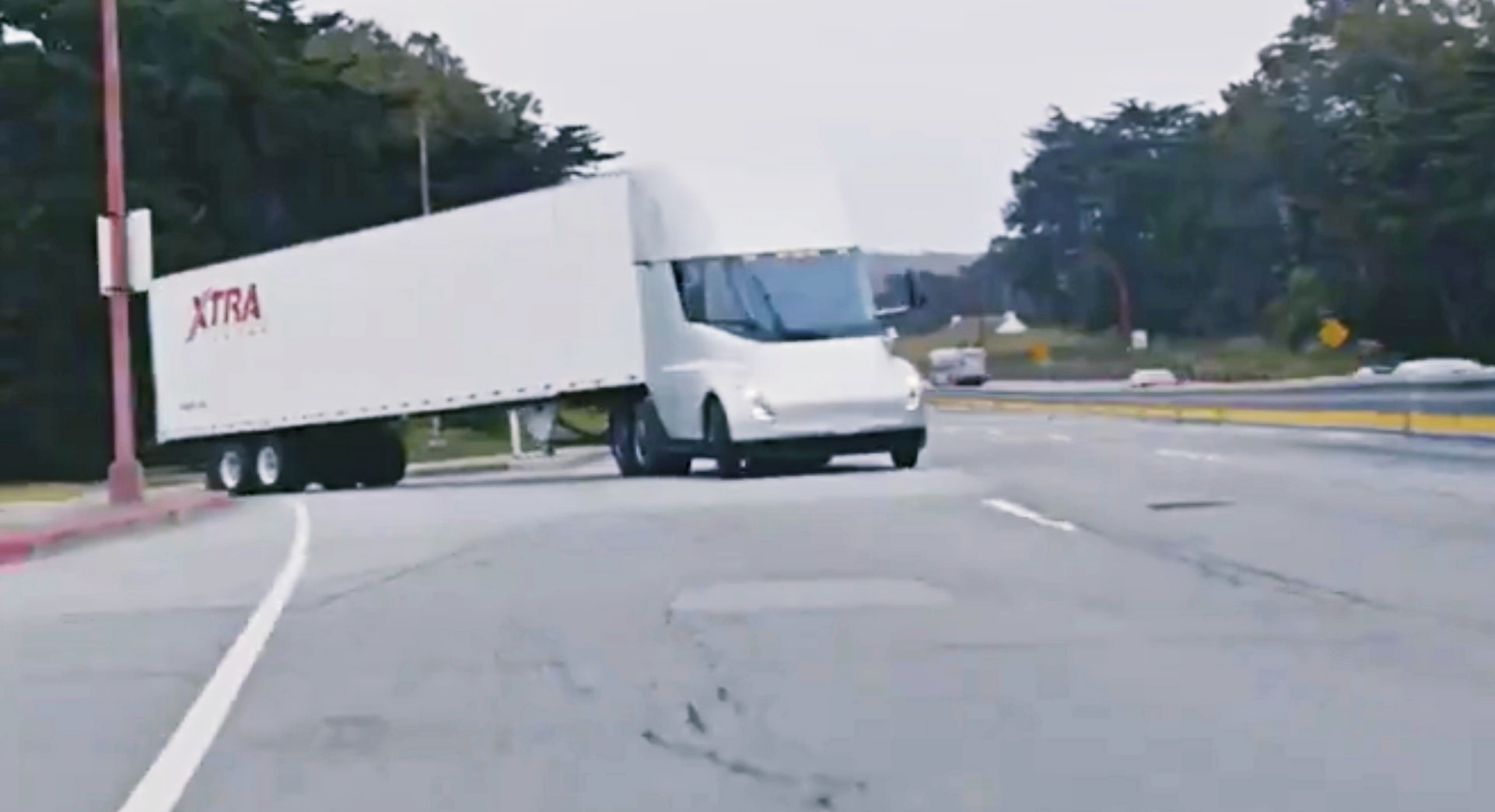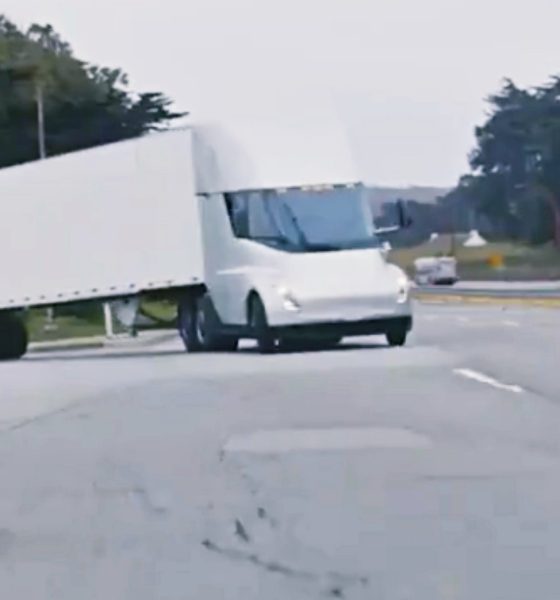

News
Tesla Semi spotted by fans ahead of Golden Gate Bridge crossing
Tesla recently shared a short video clip of the silver Semi stealthily gliding over the Golden Gate Bridge while hauling a trailer on the way to Santa Rosa, CA.
The video clip of the silver Semi, with trailer in tow, was shared on Twitter, where it caused quite a conversation among Tesla’s followers on the platform. Some remarked that the vehicle was unearthly in its silence despite seemingly traveling at near-highway speed. Others jested that the way the Semi glided over the Golden Gate Bridge almost made the vehicle look like a computer-generated image, prompting a lighthearted response from Tesla’s Twitter account assuring that the footage was indeed real.
Tesla Semi driving to Santa Rosa pic.twitter.com/5Gdk4WAJcE
— Tesla (@Tesla) June 20, 2018
In a follow-up clip featuring the electric truck heading to the Golden Gate Bridge, the logo of Xtra Lease Trailers was visible on the Semi’s cargo, suggesting that Tesla could be a client of the leasing company. Xtra Lease Trailers, a Berkshire Hathaway Company based on St. Louis, MO, is among the United States’ most prolific trailer lease providers, with a fleet of 85,000 trailers to date.
Tesla Semi driving to Santa Rosa: The Prequel pic.twitter.com/pNnF36qg3A
— Tesla (@Tesla) June 20, 2018
A Tesla fan has also shared an image of the Semi on Twitter just as it was about to enter the Golden Gate Bridge. Just like in recent sightings, such as the one near the LA Service Center — a place that holds historical significance to the company.
https://twitter.com/beau/status/1009475724191731717
While the Elon Musk-led company did not specify the purpose of the Semi’s trip to Santa Rosa on its Twitter video, Tesla’s VP of Truck Programs Jerome Guillen noted in his LinkedIn profile that the footage was taken last week, and that the trip was conducted to visit “some great local customers.”
Guillen and the team currently testing the Tesla Semi have been spotted in several areas of the United States, especially in the route between the company’s Fremont, CA factory and the Sparks, NV Gigafactory. As stated by Elon Musk earlier this year, Tesla is now using the two electric trucks as part of its fleet tasked with transporting Model 3 battery packs from Gigafactory 1 to Fremont. The two massive electric vehicles have also been spotted in the route between Tesla’s headquarters in Palo Alto, CA and the Fremont.
The Tesla Semi has been well-received by several prolific transport and trucking companies, both in the United States and abroad. During the company’s Q1 2018 earnings call, Tesla CEO Elon Musk and CTO JB Straubel noted that there are roughly 2,000 reservations for the electric long-hauler to date. So far, companies that have publicly announced their orders for the vehicle include companies such as PepsiCo, FedEx, and UPS in the United States and Bee’ah from the United Arab Emirates.
Over the past few months, the Tesla Semi has also been spotted visiting the site of several key reservation holders, such as Anheuser-Busch in St. Louis, MO. The electric truck was also demoed for PepsiCo employees in Dallas, TX. The black Tesla Semi, speculated to be the short-range variant of the vehicle, was also spotted being transported at a highway near Des Moines, IA, close to the headquarters of Ruan Transportation Management Systems, another one of the Semi’s reservation holders.
Some companies with reservations for the Tesla Semi are currently working with Tesla to set up a charging network for the massive long-haulers. Dubbed as the Megachargers, the Tesla Semi charging stations will be installed at key locations that are frequently traveled by fleet operators. This would enable truck drivers to travel between facilities without having to recharge each time they load and unload cargo.

Elon Musk
Elon Musk and Tesla AI Director share insights after empty driver seat Robotaxi rides
The executives’ unoccupied tests hint at the rapid progress of Tesla’s unsupervised Robotaxi efforts.

Tesla CEO Elon Musk and AI Director Ashok Elluswamy celebrated Christmas Eve by sharing personal experiences with Robotaxi vehicles that had no safety monitor or occupant in the driver’s seat. Musk described the system’s “perfect driving” around Austin, while Elluswamy posted video from the back seat, calling it “an amazing experience.”
The executives’ unoccupied tests hint at the rapid progress of Tesla’s unsupervised Robotaxi efforts.
Elon and Ashok’s firsthand Robotaxi insights
Prior to Musk and the Tesla AI Director’s posts, sightings of unmanned Teslas navigating public roads were widely shared on social media. One such vehicle was spotted in Austin, Texas, which Elon Musk acknowleged by stating that “Testing is underway with no occupants in the car.”
Based on his Christmas Eve post, Musk seemed to have tested an unmanned Tesla himself. “A Tesla with no safety monitor in the car and me sitting in the passenger seat took me all around Austin on Sunday with perfect driving,” Musk wrote in his post.
Elluswamy responded with a 2-minute video showing himself in the rear of an unmanned Tesla. The video featured the vehicle’s empty front seats, as well as its smooth handling through real-world traffic. He captioned his video with the words, “It’s an amazing experience!”
Towards Unsupervised operations
During an xAI Hackathon earlier this month, Elon Musk mentioned that Tesla owed be removing Safety Monitors from its Robotaxis in Austin in just three weeks. “Unsupervised is pretty much solved at this point. So there will be Tesla Robotaxis operating in Austin with no one in them. Not even anyone in the passenger seat in about three weeks,” he said. Musk echoed similar estimates at the 2025 Annual Shareholder Meeting and the Q3 2025 earnings call.
Considering the insights that were posted Musk and Elluswamy, it does appear that Tesla is working hard towards operating its Robotaxis with no safety monitors. This is quite impressive considering that the service was launched just earlier this year.
Elon Musk
Starlink passes 9 million active customers just weeks after hitting 8 million
The milestone highlights the accelerating growth of Starlink, which has now been adding over 20,000 new users per day.

SpaceX’s Starlink satellite internet service has continued its rapid global expansion, surpassing 9 million active customers just weeks after crossing the 8 million mark.
The milestone highlights the accelerating growth of Starlink, which has now been adding over 20,000 new users per day.
9 million customers
In a post on X, SpaceX stated that Starlink now serves over 9 million active users across 155 countries, territories, and markets. The company reached 8 million customers in early November, meaning it added roughly 1 million subscribers in under seven weeks, or about 21,275 new users on average per day.
“Starlink is connecting more than 9M active customers with high-speed internet across 155 countries, territories, and many other markets,” Starlink wrote in a post on its official X account. SpaceX President Gwynne Shotwell also celebrated the milestone on X. “A huge thank you to all of our customers and congrats to the Starlink team for such an incredible product,” she wrote.
That growth rate reflects both rising demand for broadband in underserved regions and Starlink’s expanding satellite constellation, which now includes more than 9,000 low-Earth-orbit satellites designed to deliver high-speed, low-latency internet worldwide.
Starlink’s momentum
Starlink’s momentum has been building up. SpaceX reported 4.6 million Starlink customers in December 2024, followed by 7 million by August 2025, and 8 million customers in November. Independent data also suggests Starlink usage is rising sharply, with Cloudflare reporting that global web traffic from Starlink users more than doubled in 2025, as noted in an Insider report.
Starlink’s momentum is increasingly tied to SpaceX’s broader financial outlook. Elon Musk has said the satellite network is “by far” the company’s largest revenue driver, and reports suggest SpaceX may be positioning itself for an initial public offering as soon as next year, with valuations estimated as high as $1.5 trillion. Musk has also suggested in the past that Starlink could have its own IPO in the future.
News
NVIDIA Director of Robotics: Tesla FSD v14 is the first AI to pass the “Physical Turing Test”
After testing FSD v14, Fan stated that his experience with FSD felt magical at first, but it soon started to feel like a routine.

NVIDIA Director of Robotics Jim Fan has praised Tesla’s Full Self-Driving (Supervised) v14 as the first AI to pass what he described as a “Physical Turing Test.”
After testing FSD v14, Fan stated that his experience with FSD felt magical at first, but it soon started to feel like a routine. And just like smartphones today, removing it now would “actively hurt.”
Jim Fan’s hands-on FSD v14 impressions
Fan, a leading researcher in embodied AI who is currently solving Physical AI at NVIDIA and spearheading the company’s Project GR00T initiative, noted that he actually was late to the Tesla game. He was, however, one of the first to try out FSD v14.
“I was very late to own a Tesla but among the earliest to try out FSD v14. It’s perhaps the first time I experience an AI that passes the Physical Turing Test: after a long day at work, you press a button, lay back, and couldn’t tell if a neural net or a human drove you home,” Fan wrote in a post on X.
Fan added: “Despite knowing exactly how robot learning works, I still find it magical watching the steering wheel turn by itself. First it feels surreal, next it becomes routine. Then, like the smartphone, taking it away actively hurts. This is how humanity gets rewired and glued to god-like technologies.”
The Physical Turing Test
The original Turing Test was conceived by Alan Turing in 1950, and it was aimed at determining if a machine could exhibit behavior that is equivalent to or indistinguishable from a human. By focusing on text-based conversations, the original Turing Test set a high bar for natural language processing and machine learning.
This test has been passed by today’s large language models. However, the capability to converse in a humanlike manner is a completely different challenge from performing real-world problem-solving or physical interactions. Thus, Fan introduced the Physical Turing Test, which challenges AI systems to demonstrate intelligence through physical actions.
Based on Fan’s comments, Tesla has demonstrated these intelligent physical actions with FSD v14. Elon Musk agreed with the NVIDIA executive, stating in a post on X that with FSD v14, “you can sense the sentience maturing.” Musk also praised Tesla AI, calling it the best “real-world AI” today.








